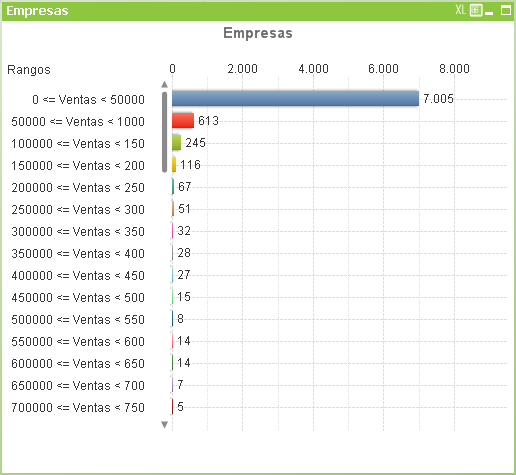Unlock a world of possibilities! Login now and discover the exclusive benefits awaiting you.
- Qlik Community
- :
- All Forums
- :
- QlikView App Dev
- :
- Number format in Class() function
- Subscribe to RSS Feed
- Mark Topic as New
- Mark Topic as Read
- Float this Topic for Current User
- Bookmark
- Subscribe
- Mute
- Printer Friendly Page
- Mark as New
- Bookmark
- Subscribe
- Mute
- Subscribe to RSS Feed
- Permalink
- Report Inappropriate Content
Number format in Class() function
Hello,
I'm using the Class() function in an Calculated Dimension as this:
= Class([Ventas 2011 (Millones)], 50000, 'Ventas')
Now, this is how the Bar Chart looks like:

And I want the numbers in the dimension to have the number format, i.e. 50.000 <= Ventas < 100.000.
How can I do that?
Thanks!
Best regards!
- Mark as New
- Bookmark
- Subscribe
- Mute
- Subscribe to RSS Feed
- Permalink
- Report Inappropriate Content
Use Num(ClassExpression,'###.###')
Example
= Num(Class([Ventas 2011 (Millones)], 50000, 'Ventas'),'###.###')
- Mark as New
- Bookmark
- Subscribe
- Mute
- Subscribe to RSS Feed
- Permalink
- Report Inappropriate Content
Ok, when I use the sentence = Num(Class([Ventas 2011 (Millones)], 50000, 'Ventas'),'###.###') I have this result:
50.000, and the classes are gone...
How can I do that without sacrifying the classes???
- Mark as New
- Bookmark
- Subscribe
- Mute
- Subscribe to RSS Feed
- Permalink
- Report Inappropriate Content
Its not possible directly
You need to do some work around
like
=Num(SubField(Class([Ventas 2011 (Millones)], 50000, 'Ventas'),' <= Ventas < ', 1),'###.###') & ' <= Ventas < ' & Num(SubField(Class([Ventas 2011 (Millones)], 50000, 'Ventas'),' <= Ventas < ',2),'###.###')
Hope this helps
- Mark as New
- Bookmark
- Subscribe
- Mute
- Subscribe to RSS Feed
- Permalink
- Report Inappropriate Content
Hi.
Class() returns dual value that has numeric value and text representation.
Num() converts text representation, so this type expressions: Num(Class()) works well without any additional 'work'.
It seems that you use implicit aggregation and that's a problem when you add another function.
Choose the aggregation explicitly:
=aggr(Num(Class([Ventas 2011 (Millones)], 50000)), [Ventas 2011 (Millones)])
- Mark as New
- Bookmark
- Subscribe
- Mute
- Subscribe to RSS Feed
- Permalink
- Report Inappropriate Content
Class() returns dual value that has numeric value and text representation.
Num() converts text representation, so this type expressions: Num(Class()) works well without any additional 'work'.
Right, class() returns a dual, but the numeric value will only hold the (AFAIR) lower limit of the interval that class() is creating. So, applying num() will only format that lower limit and replace the text value (which holds the full interval as text) with the formatted numeric value (like Juan observed also).
If you want to keep both limits of the interval in the text representation, I believe you need to use some kind of text manipulation, something along the lines Celambarasan suggested.
Would be nice if QV would just apply the standard number format by default.
- Mark as New
- Bookmark
- Subscribe
- Mute
- Subscribe to RSS Feed
- Permalink
- Report Inappropriate Content
50.000, and the classes are gone...
Thanks, Stefan, I've missunderstood.
I thought all classes rows are gone, not just '<= Ventas < N' from labels...
In that case don't see the need to use class() with string parsing functions:
=aggr(Num(Div([Ventas 2011 (Millones)],50000)*50000, '###.###') & ' <= Ventas < ' &
Num(Div([Ventas 2011 (Millones)],50000+1)*50000, '###.###'), [Ventas 2011 (Millones)])
- Mark as New
- Bookmark
- Subscribe
- Mute
- Subscribe to RSS Feed
- Permalink
- Report Inappropriate Content
You're right, if you need to change the string format that class() will return, it's probably better not to use class() at all.
And if the classification is only based on field value (no aggregation, not depending on selection state), like in the discussed chart, I think it's even better to calculate the classification in the script.
You can then use one of the classification methods discussed here:
http://community.qlik.com/message/240288#240288
Regards,
Stefan